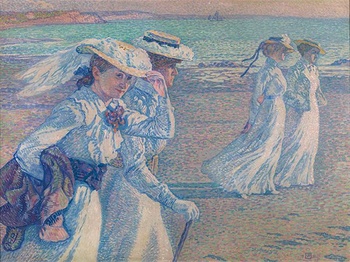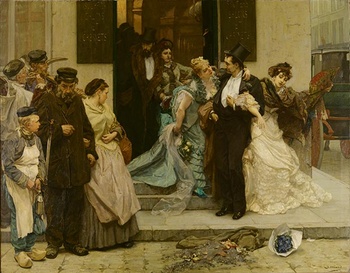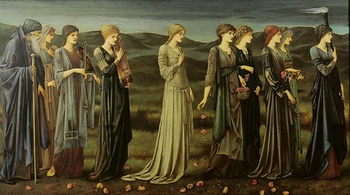(Théo van Rysselberghe, La promenade © KMSKB/MRBAB)
On 6 December the brand new Musée Fin-de-Siècle Museum opens to the public. Belgian greats such as Ensor, Van Rysselberghe, and Spilliaert, along with foreign counterparts such as Gauguin and Gallé, exemplify a kind of modern sensibility that is strikingly akin to that of our own times.
The new Musée Fin-de-Siècle Museum, which looks at developments in art between 1868 and 1914, will be the first of two complementary modern-art sections in the Royal Museums of Fine Arts of Belgium. The second, the PostmodernLab Museum in the Vanderborght building, due to open in 2016, will house art from 1914 to today. These developments involve a thorough reshuffle of a large part of the federal art collections. Inga Rossi-Schrimpf, co-curator of the Musée Fin-de-Siècle Museum, believes that the restructuring will bring in more visitors. “We will reach people with the appeal of these Belgian art collections, complemented by the unique Gillion Crowet art nouveau collection.”
Why did you decide to have the fin de siècle [end of the century] begin in 1868?
Inga Rossi-Schrimpf: It could just as easily have been 1886, the year in which Jean Moréas wrote the Symbolist manifesto. But 1868, when the Société Libre des Beaux-Arts was founded, was a turning point. That was the first artists’ association to break free from academicism and history painting – in order to capture the real world, in their determination to freely observe their surroundings. You could call it the embryonic phase of the avant-garde.
Musée Fin-de-Siècle Museum: a beginning


(Charles Hermans © KMSKB/MRBAB)
Our museum follows a chronological sequence and takes a look at both artistic circles such as Les XX and La Libre Esthétique and individual artists. It all began with realism and later the trends that were grafted onto it, including social realism, Impressionism, neo- and post-Impressionism, and Symbolism.
So you have extended the concept of the fin de siècle.
Rossi-Schrimpf: The term has for too long been wrongly understood because of that word fin. Whereas it was actually an exciting beginning. What was important then was looking at reality, to stop the clock of rapid developments such as industrialisation. There are major parallels with the speed of traffic, social media, and globalisation today. Everyone was looking for a way to react, even through mysticism. The artists of the time reacted very strongly, hence the development of modern art, film, and photography.
Our museum follows a chronological sequence and takes a look at both artistic circles such as Les XX and La Libre Esthétique and individual artists. It all began with realism and later the trends that were grafted onto it, including social realism, Impressionism, neo- and post-Impressionism, and Symbolism.
So you have extended the concept of the fin de siècle.
Rossi-Schrimpf: The term has for too long been wrongly understood because of that word fin. Whereas it was actually an exciting beginning. What was important then was looking at reality, to stop the clock of rapid developments such as industrialisation. There are major parallels with the speed of traffic, social media, and globalisation today. Everyone was looking for a way to react, even through mysticism. The artists of the time reacted very strongly, hence the development of modern art, film, and photography.

(Edward Burne-Jones, Le cortège nuptial de Psyché © KMSKM/MRBAB)
Do you illustrate that with new technology?
Rossi-Schrimpf: Nothing can replace direct contact with a work of art, but we do use a lot of extra tools. On touchscreens you can see 3-D reconstructions of opera sets from Wagnerian premieres at De Munt/La Monnaie. And we have digitally rebuilt lost art nouveau buildings such as Horta’s Volkshuis/Maison du Peuple. Cinematek, moreover, is showing documentaries that set the scene, from 19th-century swimmers in Ostend to a tram ride through Brussels. This new museum aims, above all, to evoke an atmosphere and to surprise people with less familiar works.
MUSÉE FIN-DE-SIÈCLE MUSEUM • di/ma/Tu > zo/di/Su 10 > 17.00, Regentschapsstraat 3 rue de la Régence, Brussel/Bruxelles, 02-508. 32.11, www.fine-arts-museum.be
Do you illustrate that with new technology?
Rossi-Schrimpf: Nothing can replace direct contact with a work of art, but we do use a lot of extra tools. On touchscreens you can see 3-D reconstructions of opera sets from Wagnerian premieres at De Munt/La Monnaie. And we have digitally rebuilt lost art nouveau buildings such as Horta’s Volkshuis/Maison du Peuple. Cinematek, moreover, is showing documentaries that set the scene, from 19th-century swimmers in Ostend to a tram ride through Brussels. This new museum aims, above all, to evoke an atmosphere and to surprise people with less familiar works.
MUSÉE FIN-DE-SIÈCLE MUSEUM • di/ma/Tu > zo/di/Su 10 > 17.00, Regentschapsstraat 3 rue de la Régence, Brussel/Bruxelles, 02-508. 32.11, www.fine-arts-museum.be
Read more about: Expo
Fijn dat je wil reageren. Wie reageert, gaat akkoord met onze huisregels. Hoe reageren via Disqus? Een woordje uitleg.